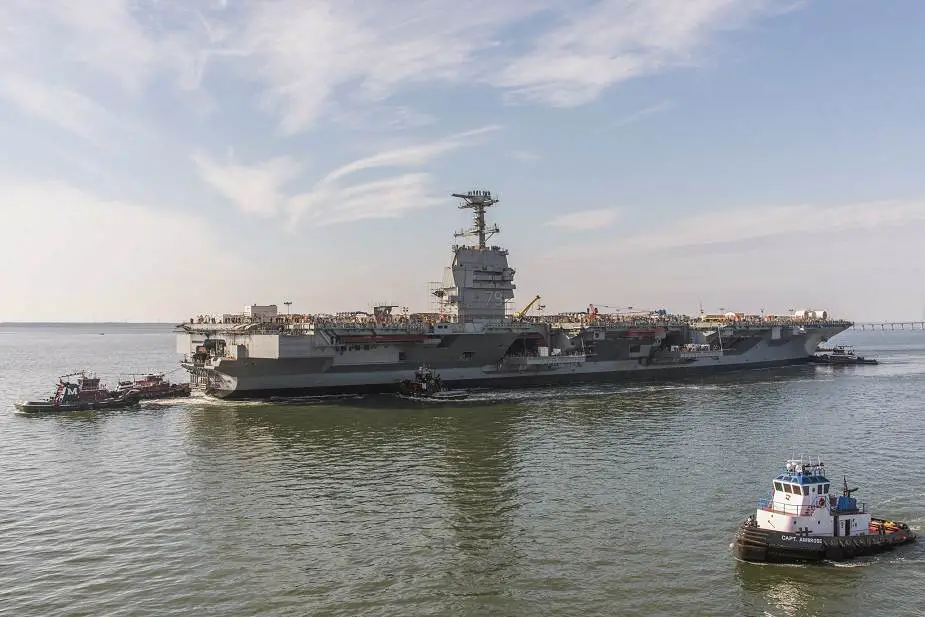According to a press release published on November 2, 2020, American Company Huntington Ingalls Industries (NYSE: HII) has received an undefinitized contract award from the U.S. Navy to shift the delivery strategy for the aircraft carrier John F. Kennedy (CVN 79) from a two-phase delivery to a single phase.
Follow Navy Recognition on Google News at this link
 Newport News Shipbuilding division successfully launched the aircraft carrier USS John F. Kennedy (CVN-79) into the James River on Monday, December 17, 2019. (Picture source Ashley Cowan/HII)
Newport News Shipbuilding division successfully launched the aircraft carrier USS John F. Kennedy (CVN-79) into the James River on Monday, December 17, 2019. (Picture source Ashley Cowan/HII)
The contract action announced on November 3, 2020, revises the two-phased delivery approach originally planned for the second ship in the Gerald R. Ford-class of carriers. It comes as a result of extensive collaboration with the Navy to support legislative requirements for Kennedy to be delivered with its complete warfare system, including F-35 Joint Strike Fighter capabilities, before the ship is commissioned into the fleet.
The contract action has a potential total value of up to $315 million, provides initial funding for the procurement of long-lead material and planning, and is expected to be definitized next year.
“We are pleased to have worked with the Navy to adopt lessons learned in the construction of USS Gerald R. Ford (CVN 78) to improve cost, production and planning efficiencies on Kennedy,” said Lucas Hicks, Newport News’ vice president of new construction aircraft carrier programs. “We believe that the single-phase approach ensures the most effective build plan for all remaining work and provides the best value for the Navy by supporting its ability to accelerate operational deployment of this maritime force asset.”
Kennedy is approximately 76% complete. The ship was launched in December 2019, and currently is undergoing additional outfitting and testing at the company’s Newport News Shipbuilding division. The ship is scheduled to be delivered to the Navy in 2024.
Kennedy will continue the legacy of highly capable nuclear-powered aircraft carrier platforms. Ford-class enhancements incorporated into the design include flight deck changes, improved weapons handling systems and a redesigned island, all resulting in increased aircraft sortie-generation rates. The Ford-class also features new nuclear power plants, increased electrical power-generation capacity, allowance for future technologies, and reduced workload for sailors, translating to smaller crew size and reduced operating costs for the Navy.
The USS John F. Kennedy (CVN-79) is the second Gerald R. Ford-class aircraft carrier being built for the United States Navy. The ship was launched on October 29, 2019, and christened on December 7, 2019. Thi type of aircraft carrier will replace USS Enterprise (CVN-65) and eventually the United States Navy's existing Nimitz-class carriers. The biggest visible difference from earlier supercarriers will be the more aft location of the island (superstructure).[18] The Gerald R. Ford-class carriers are to have a reduced whole-life cost due in part to reduced crew size.[11] These ships are intended to sustain 160 sorties per day for 30-plus days, with a surge capability of 270 sorties per day.
The Gerald R. Ford-class aircraft carrier is equipped with two newly-designed reactors and has 250 percent more electrical capacity than previous carriers. The improvements will allow the ship to load weapons and launch aircraft faster than ever before. She features a new nuclear power plant, a redesigned island, electromagnetic catapults, improved weapons movement, an enhanced flight deck capable of increased aircraft sortie rates, and growth margin for future technologies. Each Ford-class ship will operate with a smaller crew than a Nimitz-class carrier and will provide $4 billion in total ownership cost savings for the U.S. Navy.
The Gerald R. Ford-class aircraft carrier will be able to carry up to 90 aircraft, including the F-35 Joint Strike Fighter, F / A-18E / F Super Hornet, E-2D Advanced Hawkeye, EA-18G Growler electronic attack aircraft, MH-60R / S helicopters, as well as unmanned air and combat vehicles.



